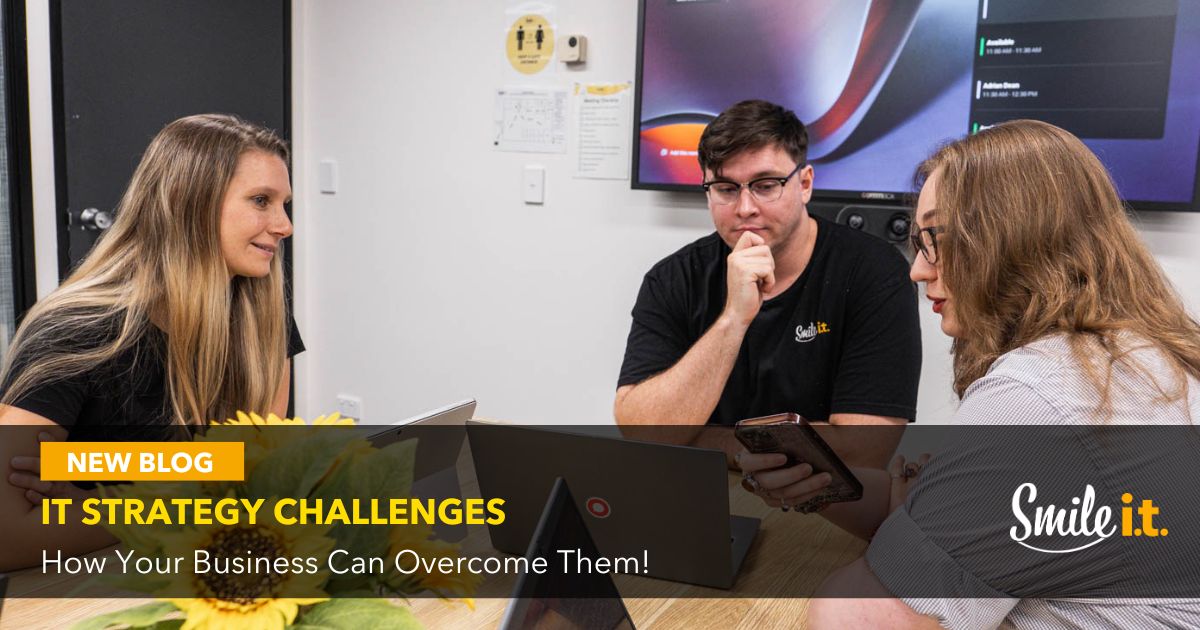It goes without saying that if technology is imperative to your operations, you want to be leveraging it to its maximum effect. It’s hard to find a business that doesn’t rely on technology in some form, whether it’s an SMB or a large enterprise. And if you don’t have a plan for how to use it effectively, you’ll end up wasting money and missing opportunities
At Smile IT, we’re advocates for having a solid IT strategy in place at your business. It helps align your technology with your business goals, creating an IT roadmap that guides your use of and decisions around technology.
Your IT strategy isn’t a ‘set and forget’, though. It requires agility, flexibility, commitment and good leadership to help deal with a range of challenges you’ll face in its implementation. Today we want to go over those challenges and give you some guidance on how to overcome them.
IT Strategy Challenges and How to Fix Them
Unclear Objectives

Unclear objectives mean no clear targets. No way to measure progress. No link between your technology and your goals. Your strategy begins to stall and your tech becomes a cost rather than an investment.
Solution: Get Clear on the ‘Why’ and Track the ‘What’
Ask the question ‘What are we trying to achieve with our technology?’ Is it an efficiency or productivity improvement? Maybe better customer service or faster response times. Once you’ve determined that, implement simple KPIs to track it. They need to be measurable, realistic and tied to business outcomes.
Then check in regularly to make sure everybody is on the same page and working together. Your strategy will start to sharpen and your tech will suddenly be pulling its weight.
Security Risks
Antivirus software and a strong password policy aren’t enough to keep your business protected. We’ve seen too many IT strategies treat security as an afterthought. And it only takes one weak spot to cause major headaches. Data breaches, downtime and reputational damage could be the result – all of which can be very costly.
Solution: Be Proactive About Security
Security needs to be part of your strategy from day one. We always recommend the ‘Essential Eight’ mitigation strategies as a great starting point for Australian businesses. Recommended by the Australian Cyber Security Centre (ACSC), it helps you form a powerful baseline of security for your business, providing a roadmap that you can follow to tighten defences.
Sticking With Old Systems for Too Long
It can be intimidating to consider overhauling your office systems and hardware. Your team are familiar with the equipment and it still gets the job done. But holding back from upgrading could be holding your business back. Older equipment is slower and harder to maintain, and generally more vulnerable to security risks. It can also reach a point where the manufacturer no longer supports it (we’re looking at you, Windows 10.)
Solution: Upgrade Without the Overwhelm
Your tech upgrades don’t have to happen all at once. Gradually and intentionally work them into your strategy, with plenty of communication, explanation and training if required.
You want seamless and stress-free transitions, so small and steady improvements are the way to go for that.
Forcing Change From Above
Your team are the ones engaging with technology every day, so it makes sense they have some kind of input into your IT strategy. Pushing down change from the top without communicating it can be a bad idea. You don’t want the people who use the tools to feel sidelined.
Solution: Talk With Your Team, Not At Them
Bring your team into the conversation about your IT strategy early on. Find out what their pain points are and listen to their ideas – you’ll create smarter and more practical solutions that way.
When the changes are incoming, give plenty of warning and explanation. The team will need time to adjust, so make sure they have that and the necessary training on the tools you’ve invested in.
Delaying Tech Adoption
You’ve heard about a new platform or tool. It sounds promising, but you put it off because it seems too risky or would be too much hassle. When you hesitate in this way, others move forward. They gain a competitive edge while you languish in your comfort zone.
Solution: Stay Curious, Stay Ready
You don’t need to jump at every shiny new tool that pops up, but you do need to stay curious and keep an eye on what’s out there. If you use a managed IT services provider, check in with them about new tech on the horizon and what you feel could benefit your business. If something looks useful, give it a test to see if it has an impact. Then you can consider rolling it out more widely.
Overcome IT Strategy Challenges With Smile IT

Challenges will pop up, and it’s how you handle those that determines the success of your IT strategy. Hopefully the above information prepares you a bit. Remember, the Smile IT team is always here to help out at whatever stage you’re at in your tech journey.
We’ve helped businesses across Australia build strategies that work – supporting their growth, protecting their data and future-proofing their operations.
We’d love to do the same for you. Get in touch today and let’s chat about your IT strategy!
When he’s not writing tech articles or turning IT startups into established and consistent managed service providers, Peter Drummond can be found kitesurfing on the Gold Coast or hanging out with his family!


